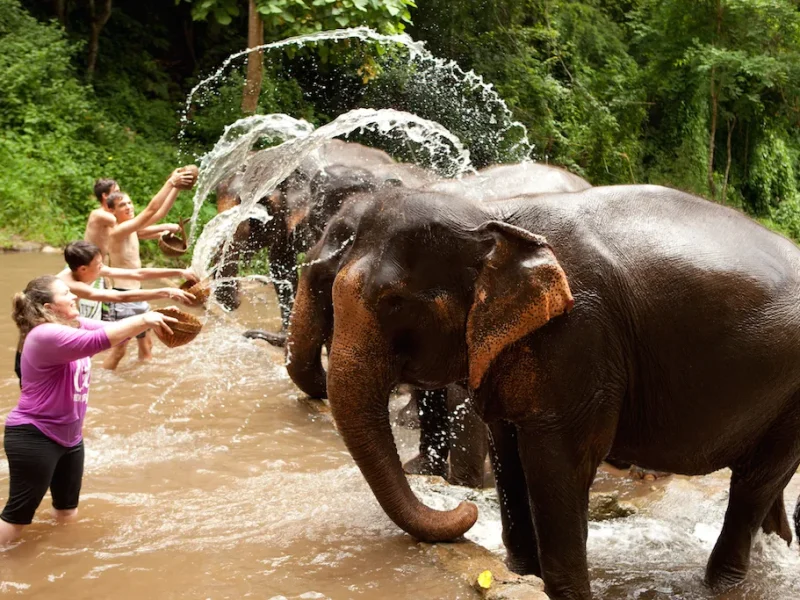The reputation of elephants in Thailand is well-deservedly high, as seen by the country’s elaborately crafted temples as well as one of the country’s most popular beers. National Symbol Of ThailandThe elephant, known in Thai as the “chang,” is the country’s official symbol. Learn what caused this to take place.
There are several explanations as to why this enormous animal was selected to serve as Thailand’s national emblem; nevertheless, one of the most important explanations is that the Thai people admired the elephant for its immense power, longevity, and resilience.
The white elephant, which is actually more of a pink elephant, is considered a symbol of monarchy in Thailand. It is said in Buddhist tradition that the Buddha’s mother had a dream on the night before her child was born in which a white elephant presented her with a lotus flower. Because of the high regard in which the animal was held, it was even shown on the flag of Siam up until the early 20th century. White elephants were reserved exclusively for use in royal ceremonies due to their extremely low population numbers.
The following is the history of the western version of the white elephant gift exchange: Because white elephants were regarded as sacred in Thailand at the time, Thai rulers would sometimes give them as gifts to their enemies, but the recipients were not allowed to work with them, make them useful in any way, or give them away. Instead, the person who received this gift had the responsibility of taking care of it, which is an expensive task. The Christmas gift exchange game got its name from the fact that the white elephant was considered a burden but could be discarded by the person who received the presents.
History of the elephant in Thailand
Beginning at the tail end of the 16th century, elephants were used for a variety of purposes in Thailand. In order to defend their kingdom against the Burmese, Malay, and Khmer invaders, the Thais made use of the size and strength of elephants in their battle strategies.
In addition to taking part in the conflicts that have taken place in Thailand, elephants have been used for a variety of tasks around the country for many centuries. Elephants were utilised in place of equipment for a variety of tasks, including the transportation of teak timber and the clearing of impenetrable forests in the north. Before they were placed to work, the elephants had training until they were ten years old; they did not become retired until they were sixty years old.
Since the beginning of the 20th century, the number of elephants in Thailand has dropped from 100,000 to fewer than 5,000, which is a very unfortunate development. Because the elephants could no longer be used for logging when it was outlawed in 1989, they were forced into the tourism industry and made to lead visitors on jungle treks or perform in front of audiences. This drove the elephants into a life of servitude.
Elephant festivals
Due to the fact that the elephant is Thailand’s national animal, it serves as the centrepiece of the country’s numerous celebrations and festivities. On the third weekend of November, hundreds of elephants take part in the Surin Elephant Rodeo, which is undoubtedly the most popular of all the rodeos, and thousands of residents attend to see the elephants play and be a part of the rituals. At the King’s Cup Elephant Polo Tournament, held annually in Bangkok, polo players from all over the globe compete while riding these creatures.
Elephants in Thailand today
In certain regions of Thailand’s jungles, it is possible to come across elephants. Recent years have witnessed a rise in the number of elephants living in the western forest of the Thungyai Naresuan Wildlife Sanctuary, which is located in the provinces of Uthai Thani, Tak, and Kanchanaburi. The number of elephants living in the Dong Phayayen-Khao Yai forest in the forest’s easternmost region has also increased. As they gradually lose their native habitat due to activities like poaching and logging, the majority of the elephant population has sought sanctuary in Thailand’s national parks.
The living circumstances of more than half of Thailand’s 3,000 captive elephants—which are employed for tourism or put to work—are not always ideal for the animals. Because keeping an elephant requires a significant financial investment, many owners are unable to meet the fundamental requirements of the animal, which can lead to overcrowding as well as other issues.
Today, a large number of visitors visit the kingdom in the hope of seeing and riding these creatures. Unbeknownst to them, however, they are contributing to a practice that is inhumane. Elephants, especially those who once freely roamed the jungles, must first go through a procedure known as Phajaan, which literally translates to “the falling in love,” during which they are tormented into submission in order to be used for riding.
Having said that, there are certain safe havens for ethical behaviour. When going to destinations such as the Elephant Nature Park in Chiang Mai, tourists may have peace of mind knowing that the animals are not being abused and are receiving proper care. In addition, tourists can have a pleasant interaction with the animals at these destinations. Boon Lott’s Elephant Sanctuary and Wildlife Friends Foundation Thailand are two examples of other ethical elephant sanctuaries in Thailand.
- My Caffeinated Journey: The Top 8 Best Coffee Shops in Bangkok - September 11, 2023
- My Encounter with Thailand’s Black and White Striped Snakes - September 2, 2023
- The Koh Samui Island Tour - July 24, 2023


